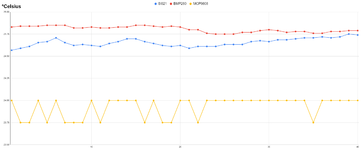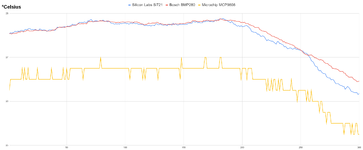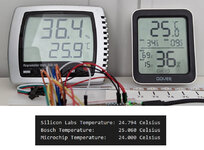I14R10
Full Member level 3
Hi
I've been playing with MCP9808 temperature sensor. In the datasheet it says its accuracy is under +/- 0.25 degrees C, and can be around +/-0.1, but It doesn't seem that way to me. I made two identical boards, each using one 9808 sensor, and compared it to my weather station reading. Now, my weather station is also not that accurate, it's WS-2300 model which costs about 70 euros for temperature and humidity sensing unit. But the problem is that one 9808 reads on average 0.5-0.7 degrees higher than my weather station, and the other reads about the same, or slightly lower. From the datasheet I expected them to be a lot closer. What I got from these two 9808 is that they can be around 0.7-0.8 degrees apart on average. And it shouldn't be that large difference between different chip readings.
I'm also looking at TMP117 sensor, which too claims that it has accuracy around 0.1 degree C, and it is quite more expensive than MCP9808, which sounds good.
So my question is, can I trust datasheets at all? Is it better to buy one relatively expensive sensor, or buy 5-10 cheaper ones, like 9808 and average their results? Do you have any sensor that you would like to recommend?
I've been playing with MCP9808 temperature sensor. In the datasheet it says its accuracy is under +/- 0.25 degrees C, and can be around +/-0.1, but It doesn't seem that way to me. I made two identical boards, each using one 9808 sensor, and compared it to my weather station reading. Now, my weather station is also not that accurate, it's WS-2300 model which costs about 70 euros for temperature and humidity sensing unit. But the problem is that one 9808 reads on average 0.5-0.7 degrees higher than my weather station, and the other reads about the same, or slightly lower. From the datasheet I expected them to be a lot closer. What I got from these two 9808 is that they can be around 0.7-0.8 degrees apart on average. And it shouldn't be that large difference between different chip readings.
I'm also looking at TMP117 sensor, which too claims that it has accuracy around 0.1 degree C, and it is quite more expensive than MCP9808, which sounds good.
So my question is, can I trust datasheets at all? Is it better to buy one relatively expensive sensor, or buy 5-10 cheaper ones, like 9808 and average their results? Do you have any sensor that you would like to recommend?



